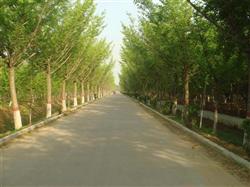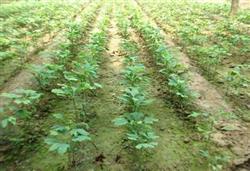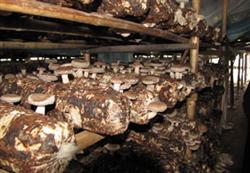Skillfully pruning and dwarfing Ginkgo biloba to get high yield

The cultivation of ginkgo biloba seedlings takes 20 years to blossom and bear fruit, while the grafted seedlings using dwarfing and dense early fruit high-yield cultivation techniques can achieve three-year fruit and benefit from five years. The growth habits of Ginkgo biloba: 1. The polarity of the seedlings of Ginkgo biloba is very strong, which can grow into tall trees. After grafting, the polarity weakens the tree posture and the branches are distributed in layers. 2. The young trees have strong sprouting ability and weak branching ability, only the tip of the branch can produce 1 or 2 long branches, and the rest are short branches. 3. Short fruit branches bear fruit. Short fruiting branches less than 1 cm short. Whether a short branch can become a fruit branch is related to its nutritional status. If there are 10 thick leaves on the short branch, it is expected to become a fruit branch. Cultivation of grafted seedlings: fully developed annual branches with full buds were cut from 30-to 40-year-old fruit trees with high yield and high quality as scions with a female-to-male ratio of 50:1. The shaping of grafted dwarf ginkgo biloba should start from the nursery, and 3 to 4 scions can be grafted on the rootstock, which is beneficial to culture into the first layer of main branches in a short time. Take only one scion and make it grow upright after branching, otherwise it will bring difficulties to shaping. Shaping and pruning: 1, tree structure: production can adopt three main branches and two layers of happy shape, trunk height 30 to 80 cm, the first layer of three main branches evenly distributed, the second layer of 2 to 3 main branches, staggered distribution with the first layer of three main branches, layer distance of 60 cm, layer spacing of 80 to 100 cm, 2 to 2 lateral branches on each main branch, lateral branch distance of 30 to 40 cm, main branch opening angle of 60 degrees. 2. fixed stem height: the trunk density of 4 × 1.5 m seedlings grafted with annual or biennial rootstocks can be determined as 30 cm to 50 cm, and that of 3-year-old rootstocks grafted with 4 × 3 m trunk can be determined as 80 cm. 3. Tree culture: the cultivation of the first layer of main branches takes 3 to 4 years, and the tree posture should be adjusted continuously by means of support, pulling, hanging and so on. While cultivating the first layer of main branches, we should pay attention to cultivating the second layer of main branches. generally, it is difficult to form the trunk on the first layer of main branches, but become cup-shaped. A strong root tiller seedling should be cultivated by making use of the strong root tillering ability of rootstock. Make it become the trunk above the first layer, make it grow to 2 to 2.5 meters, and the grafted scion grows into the second layer. 4. Pruning: ①, more cutting and less thinning: throw out all kinds of branches as far as possible, and cut short the extended branches and the parts that need to be sent out. ②, pick the heart in time, pick the heart of the auxiliary branch in time from early May to early June. ③, girdling, upside-down peeling and scratching: Wang auxiliary branches can promote flower formation from late June to early July. In sunny days, the ring peeling technique is used to promote flower formation, and the girdling width is 1 × 10 of the branch diameter, which can greatly promote flower differentiation. According to the author's experiments for many years, the flower formation rate of upside-down sticking is about 95%. The parts with missing branches can be carved on the top of the bud to promote germination.
- Prev

Breeding of Ginkgo biloba seedlings by smooth wood cutting in autumn
1. Sand culture treatment collect branches of the same year around August 20, take 20 cm long and 30 cm as cuttings, immediately remove leaves (leaving a little petiole), bundle 10 into bundles and put them into sand culture beds. The humidity of green sand in the sand culture bed is held by hand and dispersed as soon as it is loosened. After 10-15 days of sand culture, the basal tissue of the cuttings healed and produced.
- Next

The key technology of Lentinus edodes tube safe oversummer
First, choose a suitable place for summer. Can choose the bungalow of civil structure, auditorium, warehouse, also can build shady shed outdoors to spend the summer. Indoor requirements clean, cool, air convection, no direct sunlight, outdoor shady shed over the summer requirements of each border and around the open ditch, cover the film to protect against rain on rainy days. Second, the scientific placement of bacteria.
Related
- Fuxing push coffee new agricultural production and marketing class: lack of small-scale processing plants
- Jujube rice field leisure farm deep ploughing Yilan for five years to create a space for organic food and play
- Nongyu Farm-A trial of organic papaya for brave women with advanced technology
- Four points for attention in the prevention and control of diseases and insect pests of edible fungi
- How to add nutrient solution to Edible Fungi
- Is there any good way to control edible fungus mites?
- Open Inoculation Technology of Edible Fungi
- Is there any clever way to use fertilizer for edible fungus in winter?
- What agents are used to kill the pathogens of edible fungi in the mushroom shed?
- Rapid drying of Edible Fungi

